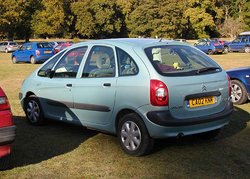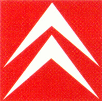|
|
CitroŽn is a French automobile manufacturer, started in 1919 by Andrť CitroŽn.
Originally a mass-market car maker with relatively straight-forward designs, CitroŽn shocked the world in 1934 with the innovative Traction Avant (front wheel drive) (1934-1956). Until the late 1980s the company had a reputation for approaching auto design in a unique way. Later significant models include the H Van (1947-1981, "HY"), 2CV (1948-1990, The "Ugly Duckling"), DS (1955-1975, "Goddess") and CX (1974-1989).
| Contents |
History
Missing image 11-cv-tavant.jpg 1934 Traction Avant 11CV |
 1960 2CV |
Missing image Citroen_Ds100.jpg 1967 DS Pallas |
The story of CitroŽn begins with the founder of the company himself, Andrť CitroŽn. After serving in the French army, he set up a gearwheel-making business. In 1919, however, the business started to produce automobiles, beginning with the conventional Type A.
In 1924, CitroŽn began a relationship with American engineer Edward Gowan Budd. From 1899, Budd had worked to develop pressed-steel bodies for railroad cars, Pullman in particular. Budd went on to manufacture steel bodies for many automakers, Dodge being his first big auto client. In 1928, CitroŽn introduced the first all-steel body in Europe. By 1930, Budd had created a prototype for CitroŽn with a unibody and front wheel drive. It was this prototype that evolved into the Onze LťgŤre and 7 CV traction avant of 1934. These cars would set the pattern to be followed thirty years later by the Mini, Volkswagen and nearly every other manufacturer.
In the beginning, the cars were successful. But soon competitors, who still used wood structure for their bodies, introduced aerodynamic body designs on their cars. CitroŽn had no way to redesign the body of his cars and the cars began to be perceived as old-fashioned. The CitroŽns sold in large quantities despite the stylistic drawback, but the car's low price was the main selling point and CitroŽn experienced heavy losses. That encouraged Andrť CitroŽn to develop the Traction Avant, a car so innovative that to it the competition would have no response. Achieving quick development of the Traction Avant was, of course, expensive and contributed to the financial ruin of the company.
CitroŽn also sponsored some expeditions in Asia (CroisiŤre Jaune) and Africa (CroisiŤre Noire), intended to demonstrate the potential for motor vehicles to cross inhospitable regions. The expeditions conveyed scientists and journalists and were a publicity success.
In 1934, debt forced the company into foreclosure; it was then taken over by its biggest creditor, the tire company Michelin.
CitroŽn unveiled the 2CV at the Paris Salon in 1948.
1955 saw the introduction of the DS, which was the first full usage of CitroŽn's now legendary hydropneumatic suspension system that was first tested on the rear suspension of the last of the Tractions. The DS featured power-operated steering, brakes, and suspension. The same high-pressure system was used to activate pistons located in the gearbox cover to operate the clutch on their "Citromatic", CitroŽn's version of a semi-automatic gearbox. This high-pressure hydraulic system would form the basis of many CitroŽn cars in the second half of the 20th century, including the SM, GS, CX, BX, XM and Xantia.
In 1965 CitroŽn took over the French carmaker Panhard in the hope of using Panhard's expertise in midsize cars to complement its own range of very small, cheap cars (e.g. 2CV/Ami) and large, expensive cars (e.g. DS/ID). In 1967 CitroŽn took control of Maserati, the Italian sportscar maker and launched the sportscar/Grand Tourer SM, which contained a V6 Maserati engine. This maneuver was unfortunately-timed, with the impending oil crisis soon to make GT manufacture unprofitable.
Huge losses caused by failure of the Maserati tie-up coupled with crippling warranty costs by the unreliable GS and CX led to Peugeot taking over CitroŽn in 1976. The combined company was known as the PSA Group.
In the 1980s, CitroŽn models were increasingly Peugeot-based. The BX of 1982 still used the hydropneumatic suspension system, but was powered by Peugeot-derived engines. By the late 80s, PSA used extensive platform sharing. The XM, for example, used the same engines and floorpan as the Peugeot 605, and the Xantia of 1993 was identical under the skin to the Peugeot 406.
CitroŽn-C4-Coupe-'04.jpg
CitroŽn developed a small car for production in Romania known as the Oltcit, which it also sold as the CitroŽn Axel.
CitroŽn's quirky approach to engineering and styling was squeezed out in favor of Peugeot conservatism. The ubiquitous 2CV was finally killed off in 1990, production having moved from France to Portugal.
In spite of the problems between Peugeot and CitroŽn, CitroŽn has continued its tradition for innovation, exemplified by new vehicles such as the C2 and the Xsara Picasso. It has even expanded into new markets, for example in China where the C3 and Xsara are alongside the ZX Fukang and Elysťe local models. The introduction of even newer models, such as the long-awaited XM replacement, the C6, indicates CitroŽn's continued commitment to innovation in the 21st century.
Passenger cars and vans

- 2CV (1948-1990)
- 8CV Rosalie (1932-1935)
- 10CV
- Acadiane (1978-1987)
- Ami 6 (1961-1971)
- Ami 8 (1969-1979)
- Ami Super (1973-1976)
- Axel (1984-1988)
- AX (1986-1998)
- Berlingo (1996- )
- BX (1982-1994)
- CX (1974-1989)
- C1 (2005- )
- C2 (2003- )
- C3 (2002- )
- C4 (2004- )
- C5 (2000- )
- C6 (2005- )
- C8 (2002- )
- C15 (1984- )
- C25 (1981-1993)
- C35 (1974-1992)
- Dyane (1967-1984)
- DS/ID (1955-1975)
- Elysťe ZX derivative for the Chinese market
- Evasion (1994-2002)
- FAF
- GS and GSA (1970-1984)
- H Van (1947-1981)
- Jumpy (1995- )
- Jumper (1994- )
- LN (1976-1979)
- LNA (1978-1986)
- M35 (1970-1971)
- Mťhari (1968-1987)
- Saxo (1995-2003 )
- SM (1970-1975)
- Traction Avant (1934-1957)
- TUB (1939-1941)
- Type A (1919-1921)
- Type B (1921-1928)
- Type C C2-C3 (1922-1926)
- Type C C4-C6 (1928-1934)
- Visa (1978-1988)
- XM (1989-2000)
- Xantia (1993-2001)
- Xsara (1997- )
- ZX (1991-1997)
Trucks
Prototypes and Concept Cars
- G Van
- Prototype C or Coccinelle
- C-60
- Project F
- Mini-Zup (1972)
- GS Camargue (1972)
- 2CV Pop (1973)
- Prototype Y
- C44 (1980)
- Karin (1980)
- Xenia (1981)
- Eco 2000 (1984)
- Eole Concept car (1986)
- Zabrus Bertone Concept car (1986)
- Activa (1988)
- Activa II (1990)
- Citella (1992)
- Xanae Concept car 1994
- Osmose Concept car
- Tulip (1995)
- C3 LumiŤre Concept car (1998)
- C6 Lignage Concept car (1999)
- Osťe Pininfarina Concept car
- Pluriel Concept car (1999)
- C-Crosser Concept car (2001)
- C-Airdream Concept car (2002)
- C-Airlounge Concept car (2003)
Miscellaneous
An old-fashioned nickname for CitroŽn cars is Citron (lemon, in French).
The company's famous "double chevron" logo derives from Andrť CitroŽn's early business in gear-cutting, the company pioneered mass production of double helically-cut gear teeth, which mesh together in a chevron.
CitroŽn is a major competitor in the World Rally Championship. On October 17, 2004, French driver Sebastien Loeb won the Driver's Championship using the CitroŽn Xsara WRC at the Rallye de France.
CitroŽn also investigated in the early seventies the possibility to produce helicopters using the Wankel engines manufactured by its subsidiary Comotor. Some models, like the CitroŽn RE2, have been flight tested and still exist.
CitroŽn's winners of the European Car of the Year award
Citroen's second and third placed entrants in European Car of the Year award
See also
External links
- CitroŽn Web Site (http://www.citroen.com/)
- CitroŽn World: over 4000 CitroŽn links (http://home.versatel.nl/CitroenWorld/)
- CitroŽnŽt (http://www.citroen.mb.ca/citroenet/index.html)
- CitroŽn Crash Test (http://home.versatel.nl/CitroenCrashTest/)
- CitCity (http://home.versatel.nl/CitCity/)
- International CitroŽn Car Club Rallye (http://www.icccr.org/)
- International Forum for C8 Drivers (http://www.eurovan2.com/)
- Citroen C4 dancing robot commercial (http://www.theembassyvfx.com/citroen.html)
Template:CitroŽnda:CitroŽn de:CitroŽn fr:CitroŽn nl:CitroŽn no:CitroŽn ja:シトロエン pl:CitroŽn sv:CitroŽn he: סיטרואן

